What’s the link between the selfie and Michelangelo Pistoletto’s Venus of the Rags? The popular trend of the self-portrait realized with a smartphone and one of the most famous works by the artist from Biella are artistically connected and physically close as never before at Gallipoli. Since 1st June, the rooms of the Castle in the Apulian city have in fact been hosting #Selfati, the first Italian exhibition entirely dedicated to the selfie, which has also been recognized by the Ministry for Cultural Heritage as an official event of the European Year of Culture 2018. This original and extremely relevant exhibition features the work symbol of Arte Povera and an icon of contemporary consumerism. #Selfati highlights and analyses, through a mosaic of languages and artists, the global phenomenon involving subjects from all generations and nationalities: who has never taken a picture of themselves and then shared it on social networks? Whether it is narcissism, exuberance, virtual entertainment or a trend, it is definitely becoming a daily modality of expression in popular culture, suitable for all.
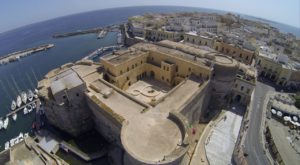
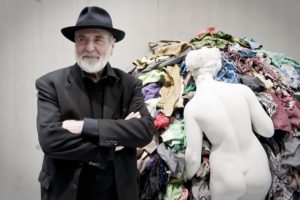
On the left: Gallipoli’s Castle. On the right: Michelangelo Pistoletto and the Venus of the Rags.
Let’s go into the details of the setup of the exhibition (running till Sunday 11th November): #Selfati includes a Selfie Timeline (a history of the self-portrait from the shaman in the Deer Cave to Marina Abramovic through Raphael, Leonardo, Caravaggio, Van Gogh and Warhol); site specific works like the “mirror tower” (a labyrinth of mirrors); the extravagant “optical room” curated and interpreted by Francesco Ferreri (aka Chekos’art), muralist and street artist; the lights of “Salento Style”. An itinerary allowing the visitor to become the author of a collective work, participating in and experiencing it. Also on display are the artist’s chairs Nemo by Fabio Novembre for Driade. The exhibition culminates in the castle’s nonagonal room, housing journalist and art influencer Clelia Patella’s “SelfieAdArte”, offering a pop interpretation of the different perceptions that can be felt in front of a work of art. In the middle of the room is Michelangelo Pistoletto’s work.

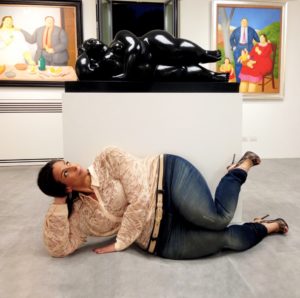
On the left: “Mi Kahlo nella parte”, Frida Kahlo, Self-portrait with Monkey, 1938, Frida Kahlo. Oltre il mito – MUDEC Museo delle Culture di Milano (2018). On the right: “Better Botero than botox2”, Fernando Botero, Lying Woman, 2006, Galleria Tega, Milano (2015).
“The Venus of the Rags – we read on the press release for the exhibition – represents a desecrating manifesto of the need for protest typical of the second half of the ‘60s. The key element is the provocative combination of waste material and the perfection of the Venus: the colourful texture of the rags accompanies the classical beauty of the neoclassical cast. Ideal beauty is irreverently juxtaposed to daily life in the final stage of a process in which the rag is reborn with the Venus, to turn into form and colour. The same goes for the selfie: a narcissistic obsession which in this exhibition becomes a participatory act thanks to the discovery of its new collective function. The communion of the image can be an instrument to get to know and share positive moments of one’s own life. The curators invite us to change the way we conceive selfies, from an excess of self-admiration to the assumption of the social responsibility of building a positive collective memory, made of relationships, respect, cultural bridges and the sharing of beauty.”

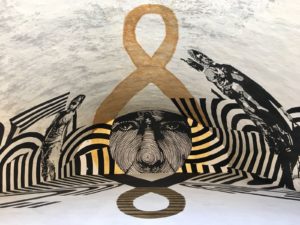
“We have now reached the tenth edition of great exhibitions in Salento, – says Raffaella Zizzari, artistic director of the exhibition and Rebirth / Third Paradise ambassadress – the series started in Otranto with Miró, Picasso, Dalì, Warhol and De Chirico and developed in Gallipoli with Michelangelo Pistoletto, Emergency and, last year, I porti del Re. We are pleased to have started a process all the other Apulian castles are following. To quote Pistoletto, “the artist is a creator, but all human beings are creative, people can therefore contribute to laying the foundations of this new world”. As a small institutions, we have responded to this ‘call to arms’ interacting as much as possible with every sector of society, combining aesthetics and ethics, animating ‘beautiful but closed’ places, proving that through effort and dedication culture always produces surprising social and economic results.
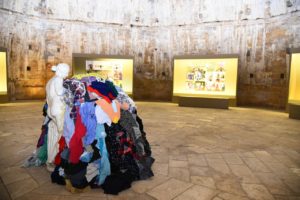
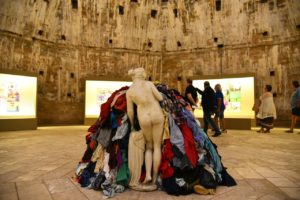
As Bergonzoni says, we’ve got to stop merely talking about ‘collective culture’, – argues the ambassadress – it is necessary to get our hands dirty to achieve a tangible outcome! We strongly believe in the social function of art, in the narrative, the accessibility and the contents of the places. Nowadays, visitors don’t want to ‘consume’ art silently, but rather participate in it. And that’s why we have conceived an exhibition involving the visitor from the very beginning, who can enjoy works of art by great artists through more pop and less academic languages. The selfie, in this exhibition, is a means to draw art closer to daily life, through the dimension of representing and sharing an image.”

The exhibition – the first of the forth series of great exhibitions of the cultural hub run by the communication agency Orione di Maglie, under the general direction of Luigi Orione Amato e the artistic direction of the architect Raffaella Zizzari – is produced by Orione Comunicazione, in collaboration with the University of Salento and the support of the Ministry for Cultural Heritage and Tourism, Regione Puglia, Provincia di Lecce, Comune di Gallipoli and La Sapienza in Rome.
“The Venus of the Rags”, Christian Boltanski, Dispersion, 1991, Take me I’m Yours, Pirelli Hangar Bicocca, Milan (2017).

